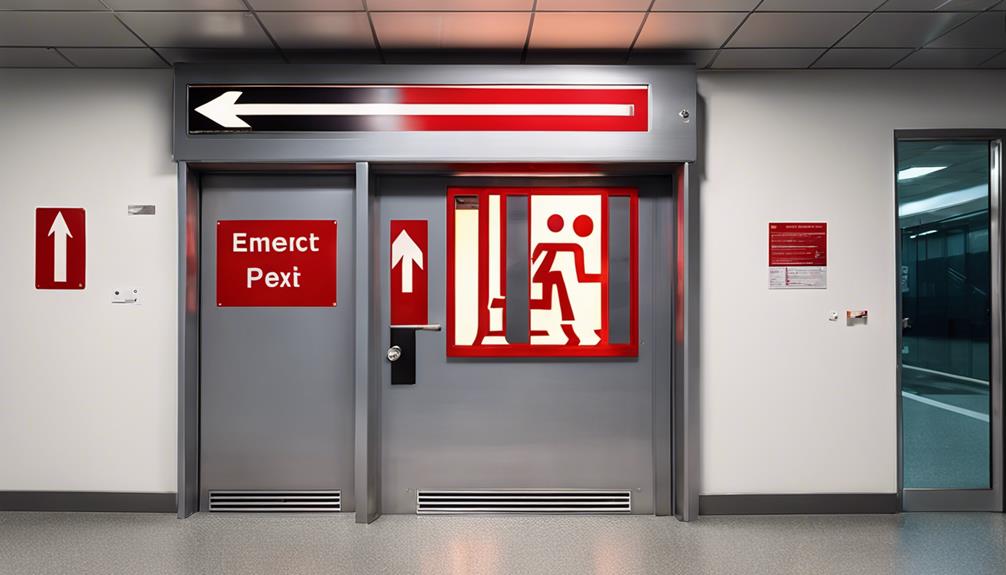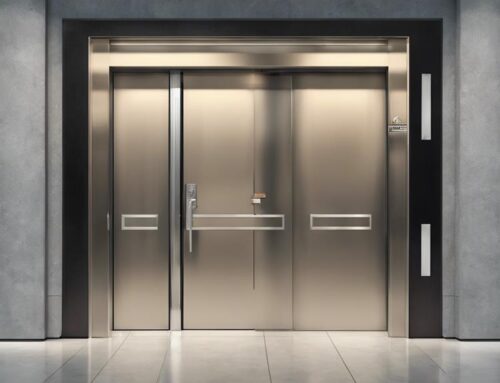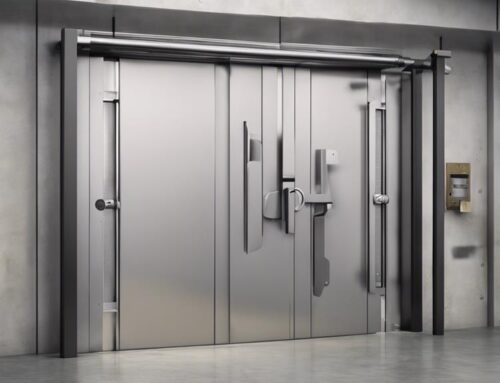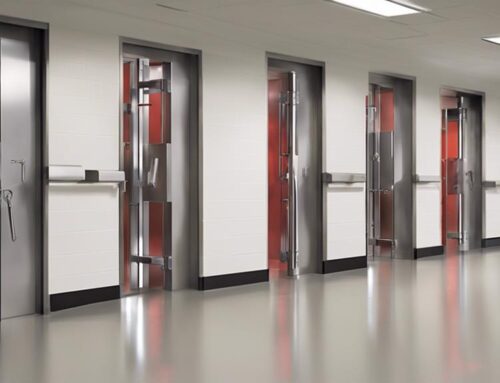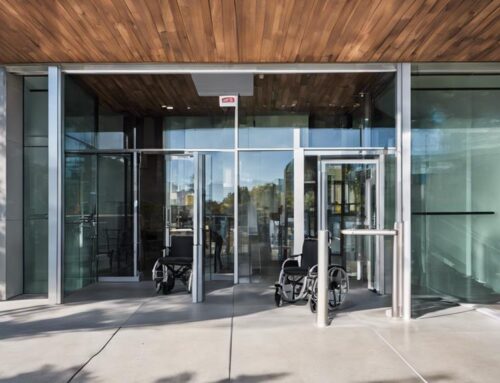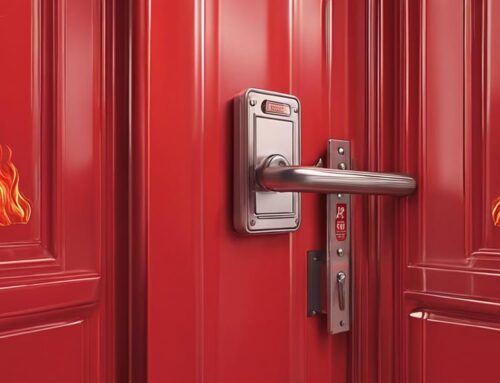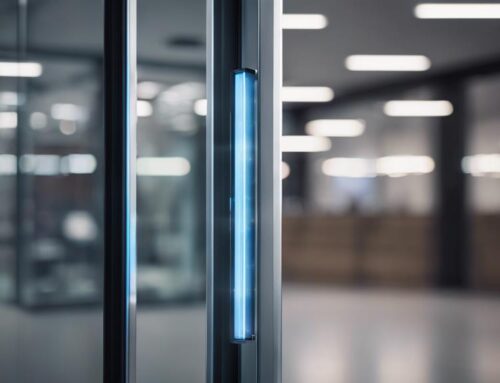Making certain your panic bar hardware complies with fire code safety laws is essential. You need to install devices that meet NFPA 101 requirements, such as mounting between 34 to 48 inches above the floor and making certain doors swing outward. Regular inspections for operational integrity and adherence to ADA standards are important. Panic bars should require no more than 15 pounds of force to operate, and documentation of all inspections and maintenance is imperative. This helps you avoid penalties and makes certain safe egress during emergencies. If you're interested, we can guide you through best practices for maintaining compliance and enhancing safety.
Key Takeaways
- Panic bars must comply with NFPA 101 and local fire codes for safe emergency egress.
- Installation requires mounting panic bars 34 to 48 inches above the floor.
- Panic hardware must allow door release with no more than 15 pounds of force.
- Regular inspections and maintenance ensure compliance with fire safety regulations.
- Documentation of testing and maintenance activities is essential for compliance verification.
Consultation Services (Expert consultation on the appropriate panic bar hardware based on fire code regulations and business needs.)
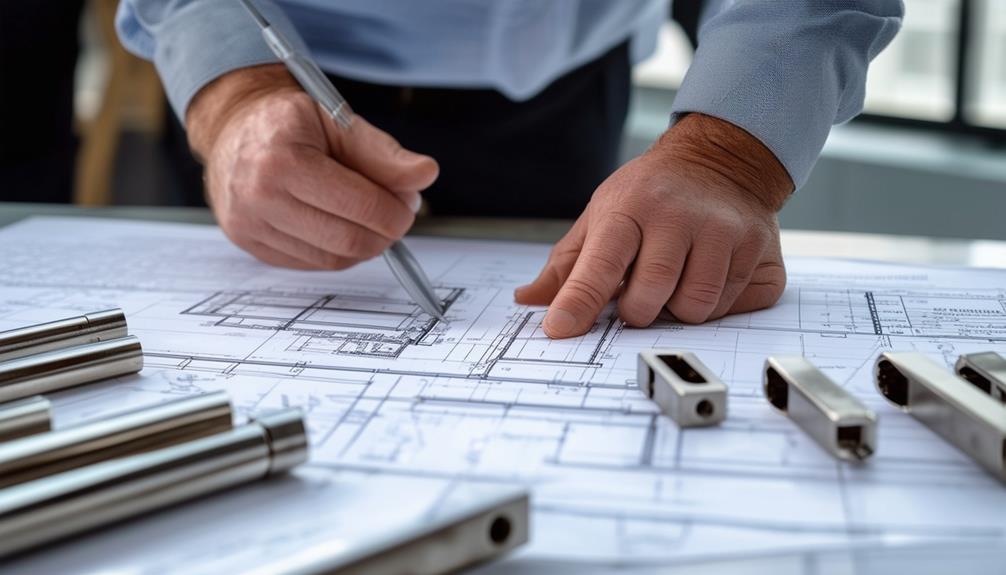
Consultation services frequently provide the essential expertise you need to select the right panic bar hardware that complies with NFPA 101 and local fire code regulations. These services focus on evaluating your specific business needs and occupancy loads to recommend panic bar hardware that guarantees safe and efficient egress during emergencies. By understanding panic bar fire code compliance, consultants help you navigate the intricacies of panic bar legal requirements. Experts often reference detailed information on requirements to guarantee the hardware meets ADA standards, thereby enhancing overall safety and accessibility.
Experts conduct thorough reviews of your existing installations to determine if they meet current codes. If upgrades or adjustments are necessary, they identify the most effective solutions to enhance safety performance. This involves detailed knowledge of panic bar hardware specifications, such as height and placement relative to adjacent walls, to guarantee maximum accessibility and functionality.
Moreover, professional consultation doesn't end with initial recommendations. Ongoing services include regular inspections and updates to keep your organization compliant with evolving fire safety standards. This proactive approach guarantees that your panic bar systems not only meet today's legal requirements but are also prepared for future changes in fire codes. By leveraging expert consultation, you can maintain a safe environment and adhere to all necessary regulations efficiently.
Fire Code Compliance Installation (Installing panic bar hardware that meets fire safety laws, ensuring safe egress in emergencies.)
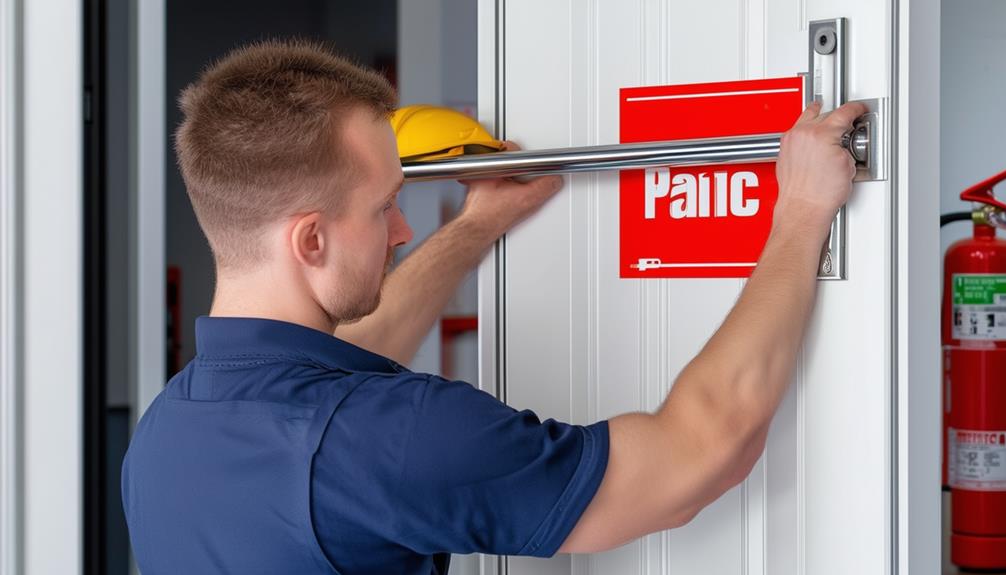
Proper installation of panic bar hardware is essential to guaranteeing fire code compliance and safe egress during emergencies. To meet panic bar fire safety laws, you'll need to install panic bar hardware on exit doors that swing outward, adhering to NFPA 101: Life Safety Code. This will assure a quick and unobstructed egress in an emergency situation. For further guidance on the importance of these devices, refer to the significant role of panic bars in fire safety, which highlights how they enhance safety during emergencies.
For panic bar code compliance, verify the hardware is mounted between 34 to 48 inches above the floor, making it accessible to all users. The panic bar should not need tight grasping, twisting, or pinching to operate, with a force requirement typically limited to 15 pounds for latch release. It's fundamental that the door has a minimum clear opening width of 32 inches and is placed at least 15 inches away from adjacent walls to avoid any obstruction.
During panic bar hardware installation, pay close attention to these detailed guidelines to guarantee compliance. Regular maintenance and inspections are essential for confirming the functionality and continued adherence to fire safety regulations. Accurate documentation of these inspections is necessary for passing audits and guaranteeing your building remains a safe environment for all occupants.
Testing and Certification(Performing tests on installed panic bar systems to certify compliance with fire safety regulations.)
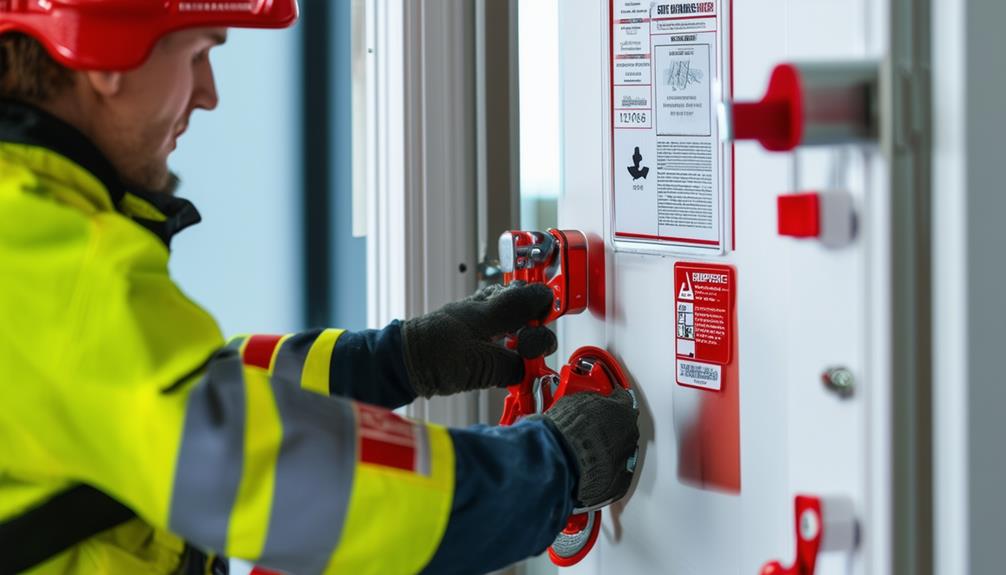
Ensuring that your panic bar systems are operational and compliant with fire safety regulations involves rigorous testing and certification processes. You need to perform regular panic bar hardware inspections to confirm they allow for quick egress under emergency conditions. Monthly functional tests are recommended, and annual inspections by qualified personnel are mandated by NFPA codes to verify the operational integrity of your panic bars. Additionally, technicians specialize in efficient service delivery, utilizing top-quality products for long-lasting results.
During these tests, you must check the force required to operate the panic bar. This force should not exceed 15 pounds, although some jurisdictions may impose a stricter limit of 5 pounds. Ensuring these parameters are met is essential for effective panic bar hardware certification.
Documentation is a critical component of compliance. You must meticulously document all testing and maintenance activities to maintain compliance with fire safety regulations. These records need to be kept up-to-date and ready for review during safety audits.
Upgrades for Existing Systems (Upgrading older panic bar systems to meet current fire code safety standards.)
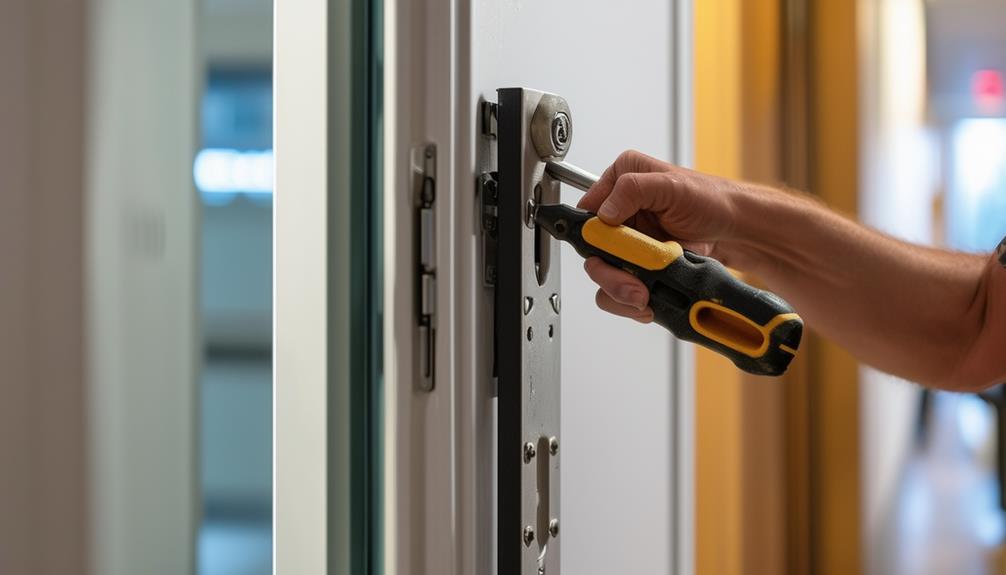
Upgrading older panic bar systems to meet current fire code safety standards is a critical task that guarantees both safety and compliance. First, you'll need to verify that your existing panic bar hardware meets the NFPA 101 requirements. This standard stipulates that panic hardware is necessary for assembly and educational occupancies with specific occupant loads. Ascertain your panic bars comply with the actuating force requirement, which should not exceed 15 pounds, though some areas enforce stricter limits of 5 pounds. Additionally, according to global usage trends, it's important to take into account regional variations in safety standards that may impact compliance.
Next, check that the installation meets modern mounting height requirements. The actuating device must be positioned between 34 to 48 inches above the floor to ensure accessibility for all users. Also, you must remove any additional locking devices on exit doors equipped with panic hardware, as current codes mandate unobstructed egress.
Regular panic bar hardware maintenance is essential for these upgraded systems. Conduct frequent inspections to confirm that the hardware functions correctly and document compliance for safety audits and inspections. These steps will help you remain aligned with panic bar hardware standards and ensure your facility is protected and compliant with fire code upgrades.
Training for Staff (Providing training for business staff on the proper use and maintenance of panic bar systems for emergency situations.)
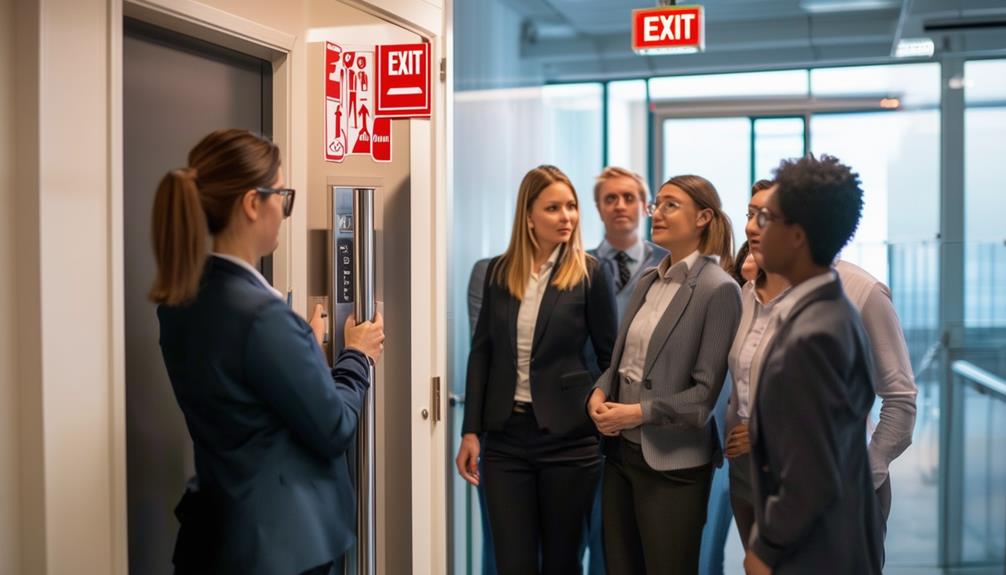
Training your staff on the operation and maintenance of panic bar systems is an essential component of guaranteeing safety and compliance in emergency situations. Start by providing thorough training on the single-motion requirement of panic bar hardware. This guarantees every team member understands how to quickly and effectively use the system during an emergency. Regular routine maintenance of these devices also plays a vital role in their functionality.
Conduct regular drills to familiarize employees with panic bar functionality. These exercises reinforce the importance of swift evacuation protocols and help identify any potential issues before they become vital. During training, emphasize the importance of inspecting panic bars for obstructions and mechanical issues. Proper maintenance guarantees these devices remain fully operational and compliant with panic bar safety laws.
Educate your staff on the compliance requirements set by the NFPA and local codes. Highlight the legal implications of non-compliance, which could be severe during emergency situations. Understanding these regulations is key to maintaining a safe environment and avoiding potential penalties.
Lastly, document each training session and track attendance. This practice not only aids in compliance and safety audits but also fosters a culture of safety within your organization. Following these panic bar hardware best practices guarantees your staff is well-prepared and your facility remains compliant.
Documentation and Reporting (Offering documentation services to keep track of compliance with fire safety laws for insurance and regulatory purposes.)
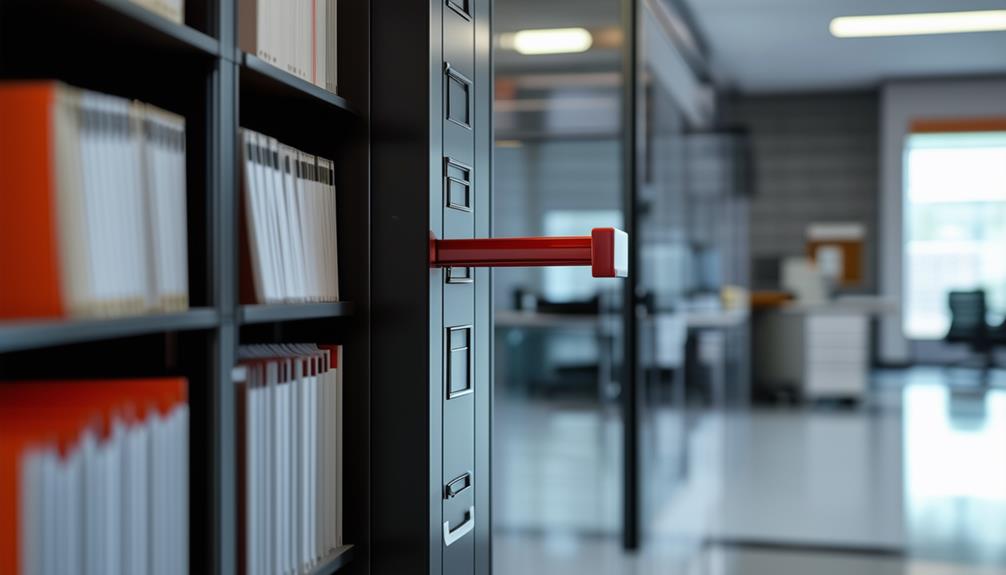
When it comes to fire safety compliance, keeping meticulous documentation of your panic bar hardware inspections and repairs is non-negotiable. Extensive records are essential for adhering to NFPA standards, which mandate regular verification of all safety measures. By documenting monthly functional tests and annual inspections by qualified personnel, you demonstrate adherence to fire safety regulations and panic bar code requirements.
Regular inspections can be facilitated through affordable compliance inspections from specialized services. Your documentation should include detailed logs of any obstructions or mechanical issues identified during inspections, as well as the dates and actions taken for repairs. These records not only guarantee compliance with panic bar legal guidelines but also provide critical evidence for insurance claims in case of an emergency. Accurate maintenance records can greatly impact your ability to claim insurance benefits by proving that all fire safety measures were up to date.
Regular audits of your documentation practices are also essential. They help you stay updated on local code changes, guaranteeing ongoing compliance with evolving safety standards. By maintaining thorough and accurate records, you're not just meeting panic bar hardware solutions requirements; you're safeguarding your organization's future and securing the safety of everyone in your building.
Frequently Asked Questions
What Are the Code Requirements for Panic Hardware?
You've got to guarantee panic hardware meets specific code requirements. For spaces with 50+ occupants or high-hazard areas, install it 34-48 inches above the floor and at least half the door's width. It should operate with no more than 15 pounds of force, sometimes less. Avoid additional locking devices unless approved. Regularly inspect and maintain it, documenting compliance with NFPA and local regulations.
What Are the Standards for Panic Hardware?
For panic hardware standards, guarantee the actuating device is at least half the door's width and mounted 34-48 inches above the floor. The force to operate it shouldn't exceed 15 pounds, though some places might require 5 pounds. No additional locks are allowed, except for compliant delayed or controlled egress devices. Regular inspections and maintenance are essential, with monthly tests and annual checks by qualified personnel.
What Are the ADA Requirements for Panic Bars?
You need to install panic bars at a height between 34 to 48 inches above the floor to comply with ADA requirements. Confirm they're operable with a single motion, without tight grasping, twisting, or pinching, and provide a clear opening width of at least 32 inches. The force to operate them shouldn't exceed 5 pounds. Regular inspections and maintenance are essential to maintain ongoing compliance with ADA standards and local building codes.
Where Is Panic Hardware Required in NFPA 101?
In NFPA 101, you must install panic hardware in assembly and educational occupancies with an occupant load of 100 or more. High hazard areas require it regardless of the number of occupants. For daycare facilities, it's necessary if there are 6 or more individuals. Remember, residential, business, and mercantile occupancies generally don't need panic hardware unless they include assembly or educational spaces with the specified occupant loads.
Conclusion
Surprisingly, ensuring your panic bar hardware complies with fire code regulations isn't just about avoiding fines—it's about saving lives. You'll find that expert consultation, meticulous installation, thorough testing, and regular upgrades aren't just bureaucratic hoops to jump through. They're essential steps to protect your business and everyone in it. With proper staff training and detailed documentation, you'll not only meet compliance standards but also gain peace of mind. Because, ironically, safety shouldn't be left to chance.

